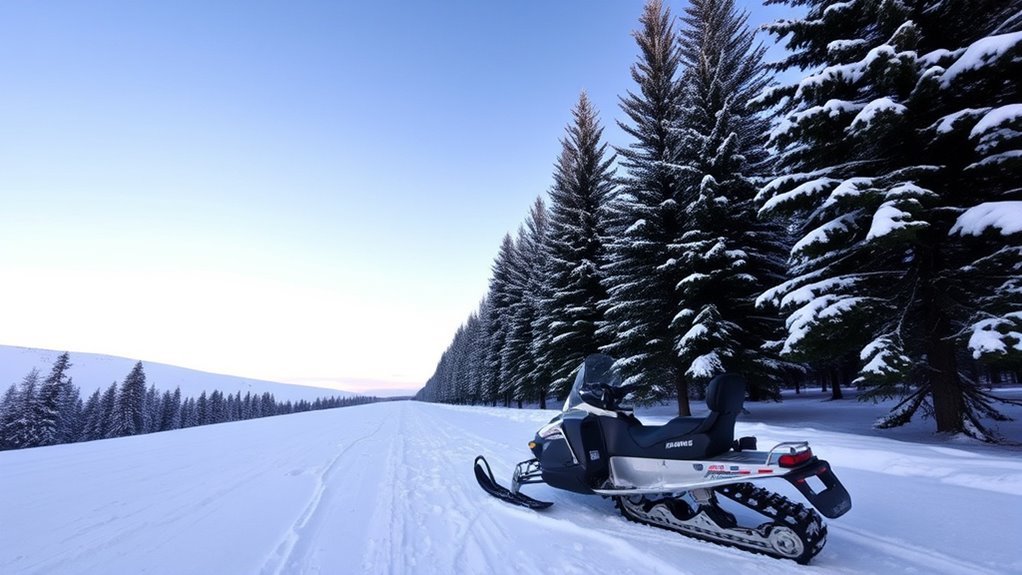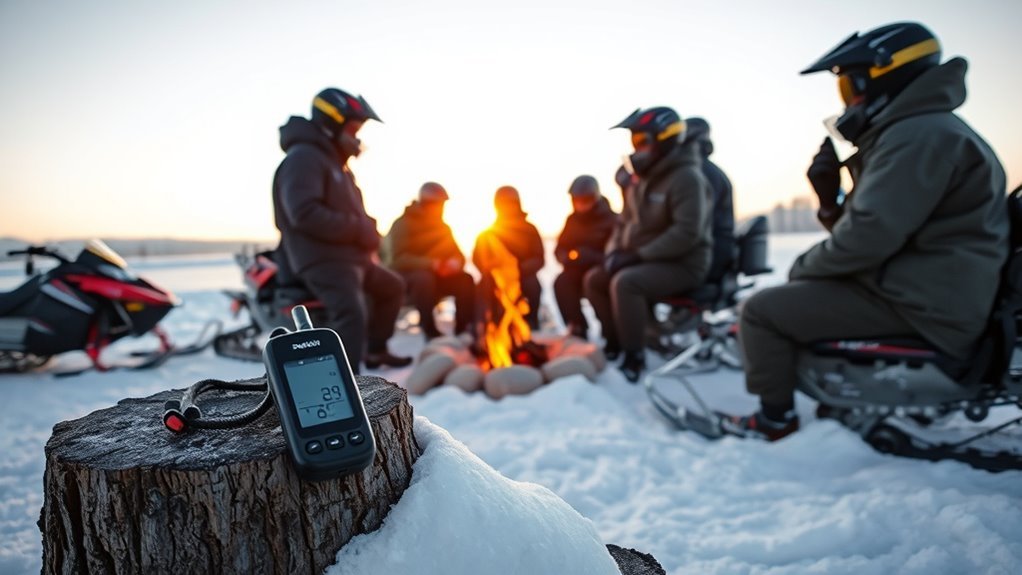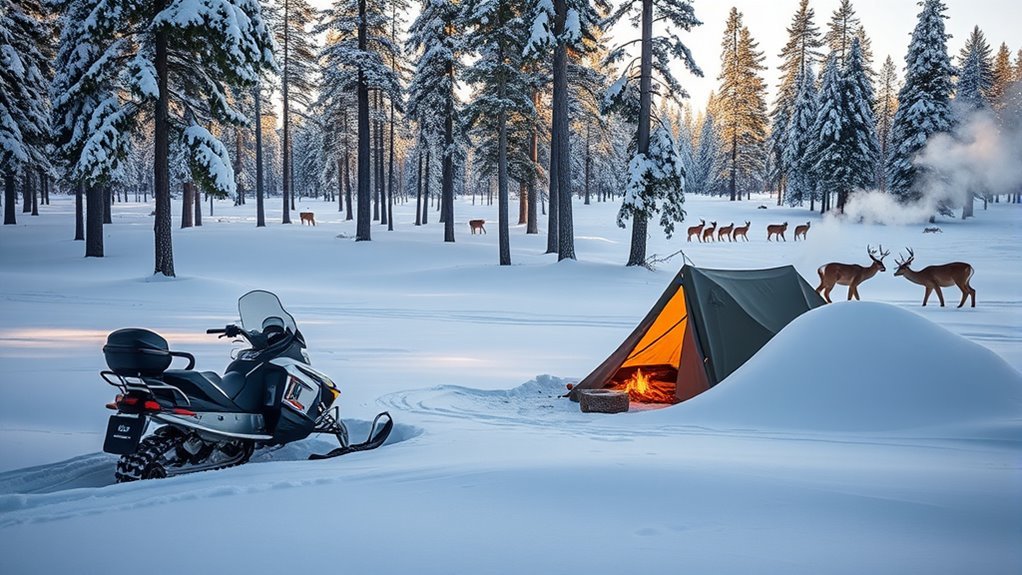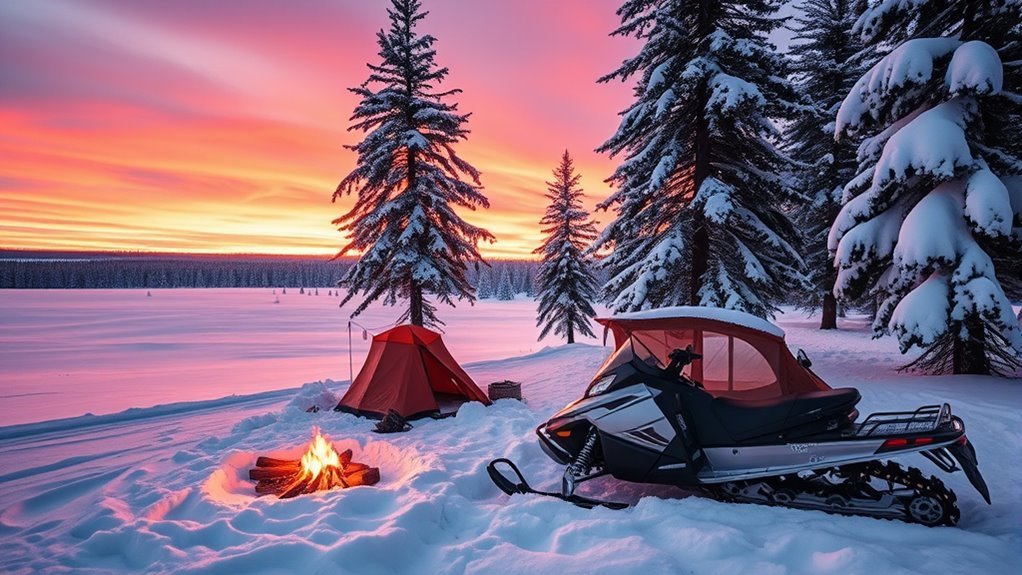Starting on a snowmobile camping trip offers a blend of exhilaration and serenity as you traverse stunning winter landscapes. You’ll face the thrilling challenge of cold weather and steering through rugged terrain. You guarantee safety by dressing in layers, keeping a close eye on weather conditions, and packing essentials like a GPS and first aid kit. This unique adventure promises unforgettable moments, but there’s more to uncover before you embark on this frosty journey.
Key Takeaways
- Expect to navigate snowy trails using GPS and maps; always protect them from snow and water damage.
- Be prepared with layered synthetic or wool clothing, avoiding cotton, to stay warm and dry.
- Anticipate the need for a portable stove for cooking and keeping warm in extreme cold.
- Pack necessary survival items like a multi-tool, snow probe, and emergency first aid kit.
- Plan for high-calorie snacks and insulated water containers to maintain energy and hydration.
Planning Your Route and Navigating Trails

When planning your snowmobile camping trip, you should start by researching trails and parks to confirm snowmobile access and identify safe camping areas.
Check for any required permits or passes to guarantee a smooth journey. Monitoring weather conditions closely before and during your trip is vital; you’ll need adequate snow coverage for safe navigation and to avoid hazardous situations.
It’s wise to use GPS and traditional maps to navigate, keeping them safe from snow and water damage. Preparing alternative routes is essential in case of changing snow conditions or trail closures.
Remember to inform local authorities of your planned route and expected return. This will enhance your safety and guarantee assistance during your adventure.
Clothing and Gear Essentials
As you prepare for your snowmobile camping trip, focus on dressing in layers to manage body temperature and protect against harsh conditions.
Opt for a snowmobile suit, insulated gloves, goggles, a helmet, and a face mask. Avoid cotton clothing; choose synthetic or wool materials that wick moisture and insulate well.
When you pack for a snowmobile adventure, essential gear guarantees comfort and safety:
- Below Zero F sleeping bag: Ideal for winter camping, rated for -40°F.
- Winter tent and insulated sleeping pads: Provide warmth during cold nights.
- Portable stove with fuel: Essential for cooking meals efficiently.
- First aid kit and navigation tools: GPS, map, and compass for guidance.
Wilderness Survival Items and Emergency Preparedness

Venturing into the wilderness on a snowmobile camping trip requires careful preparation for unexpected situations, ensuring safety and comfort. Start by planning and packing essential wilderness survival items. A GPS, a map, a compass, and a multi-tool will aid in navigation and repairs.
| Item | Purpose | Importance |
|---|---|---|
| GPS, Map, Compass | Navigation | Crucial for finding your way |
| Multi-tool | Repairs and Utility | Versatile for various tasks |
| Small Stove | Cooking and Warmth | Necessary for meal prep and heat |
| Snow Probe, Shovel | Snow Emergencies | Critical for safety |
| First Aid Kit | Treating Injuries | Necessary for health maintenance |
Include a first aid kit in a waterproof bag. Don’t forget a small stove, fuel, fire starters, and dry kindling for warmth. Emergency preparedness is key, so bring a solar charger and spare batteries to maintain communication.
Bluetooth Communication and Staying Connected
After ensuring you’ve packed all necessary survival items, it’s important to contemplate how you’ll communicate and stay connected during your snowmobile camping adventure.
Bluetooth communication is key. Snowmobile helmet communicators offer a hands-free phone interaction, ensuring you stay in touch with your group and navigate with ease.
Here’s how to enhance your connectivity:
- Install helmet communicators: This enables easy, hands-free chats with group members, enhancing safety by keeping everyone informed.
- Mount your phone or GPS: Mount these devices on your snowmobile for quick reference so you don’t have to stop.
- Use wireless headsets: Stay updated on route changes and potential hazards without removing your hands from the handlebars.
- Maintain contact with local authorities: Crucial for emergency tracking and safety assurance.
Safety Precautions and Health Monitoring

While starting a snowmobile camping trip, prioritizing safety precautions and health monitoring is essential.
First, ensure everyone wears appropriate clothing, including insulated layers, to maintain warmth and prevent moisture buildup. Then, monitor all group members regularly for signs of hypothermia, dehydration, and frostbite. These conditions can develop quickly in cold weather, especially during prolonged exposure.
Watch for symptoms like excessive shivering, fatigue, or confusion, which may indicate worsening conditions. Conduct health checks throughout the trip, paying attention to these warning signs.
Establish a reliable communication plan using devices like ham radios or GPS, so everyone can promptly report health concerns or emergencies. Stay aware of changing weather conditions and adjust your itinerary to ensure group safety and health.
Food, Hydration, and Cooking on the Go
As you prioritize safety and health on your snowmobile camping trip, don’t overlook the importance of proper nutrition and hydration. Keeping your energy levels up is essential, so plan your food and cooking approach efficiently.
Here’s a quick guide:
- Precooked and Prewrapped Foods: Choose options like brats or potatoes for easy heating, minimizing cooking time in the cold.
- High-Calorie Snacks: Pack granola bars or summer sausage for quick energy bursts while riding.
- Hydration: Carry plenty of water in insulated containers to prevent freezing, which will offer you a warm drink in chilly conditions.
- Portable Cooking Gear: A mini camping stove can heat food, but its efficiency may drop in extreme cold.
Select light, easy-to-digest meals, avoiding heavy foods.
Wildlife Awareness and Respecting Nature

Understanding and respecting the wildlife in your camping area enriches your snowmobile adventure while ensuring safety for you and the local animals. Start by familiarizing yourself with the local wildlife, including moose, deer, and birds. Knowing their behaviors and habitat needs helps you maintain a safe distance, minimizing stress on animals and keeping you safe.
Be mindful of seasonal patterns, as some species are more active during certain times, impacting your activities.
Always follow Leave No Trace principles. Dispose of waste properly and keep noise to a minimum to preserve the environment and its inhabitants.
Also, research and adhere to local regulations regarding wildlife interactions and feeding. These guidelines protect the animals and the ecosystem, ensuring a responsible and respectful adventure.
Comfort and Warmth in Cold Weather Camping
When you’re out in the cold, staying warm and comfortable is essential for an enjoyable camping experience. To maintain your body heat, focus on these key strategies:
- Please dress in Layers: Start with moisture-wicking base layers to keep dry, add insulating layers for warmth, and finish with a windproof outer layer to seal it all in.
- Sleeping Bags: Invest in a high-quality, extreme-temperature-rated bag, like one for -40°F, paired with foam pads to insulate against the cold ground.
- Warm Gear: Keep boot liners and extra clothes inside your sleeping bag overnight to guarantee they’re warm and ready in the morning.
- High-Calorie Foods: Regularly consume warm, energy-rich meals and drinks to sustain your body’s warmth and energy throughout the day.
Conclusion
On your snowmobile camping trip, embrace the thrill of exploring snowy trails while staying prepared for the challenges ahead. Dress in layers, pack essential gear, and keep safety in mind. With a reliable GPS, first aid kit, and emergency items, you’ll navigate the wilderness confidently. Stay connected with Bluetooth communication and respect the natural environment. Planning carefully and prioritizing comfort and safety allows you to enjoy a rewarding adventure that balances excitement with tranquility.
FAQs
1. How Strenuous Is Snowmobiling?
Snowmobiling is pretty demanding. You’ll need core strength and endurance to handle uneven trails. Expect fatigue from cold exposure and constant maneuvering. Your arms and shoulders might get sore, especially during intense parts, which burn 300-600 calories per hour.
2. Is Snowmobiling Hard for Beginners?
Snowmobiling isn’t too hard for beginners, but it requires some skill. Start on flat, groomed trails to build confidence. Remember, practice throttle control and balance. Consider taking a lesson to learn valuable tips and techniques.
3. What Does Boondocking Mean Snowmobile?
When you boondock on a snowmobile, you explore off-trail, unmarked areas. You navigate deep powder and natural terrains, facing challenges like trees and slopes. It requires skill and safety gear, including avalanche equipment, to guarantee a safe adventure.
4. What Not to Do on a Snowmobile?
Don’t tow objects behind your snowmobile; it risks accidents. Never ride alone in remote areas; always go with a group. Avoid speeding, check weather forecasts, and stick to marked trails to guarantee a safe snowmobile experience.

